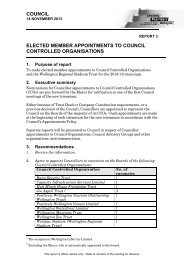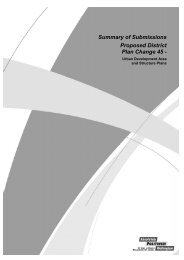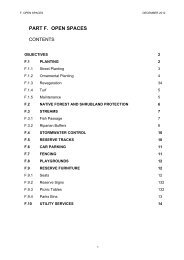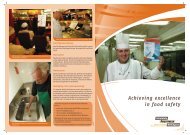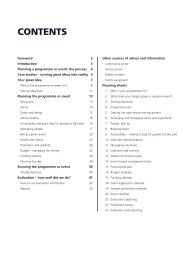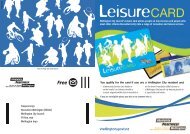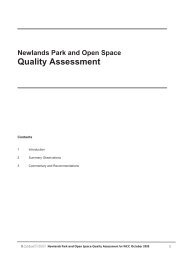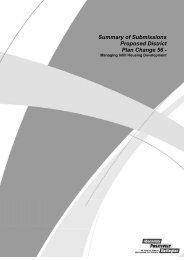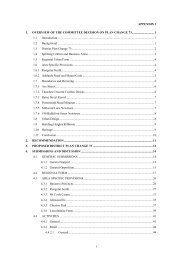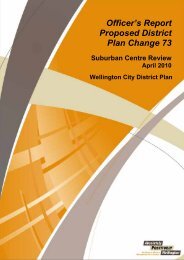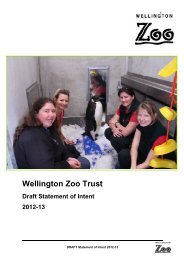Explore Wellington - Northern Walkway - Wellington City Council
Explore Wellington - Northern Walkway - Wellington City Council
Explore Wellington - Northern Walkway - Wellington City Council
You also want an ePaper? Increase the reach of your titles
YUMPU automatically turns print PDFs into web optimized ePapers that Google loves.
1 The walk starts at the end of<br />
Truscott Avenue in Johnsonville<br />
Park. Follow the orange directional<br />
signs up the hill to the first of two<br />
tunnels on the walk.<br />
2 Johnsonville<br />
Reservoir<br />
The tunnel was hewn<br />
through solid rock to<br />
accommodate the (now disused)<br />
outlet pipe from the reservoir. In 1910<br />
the Johnsonville Town Board<br />
purchased land on the northern and<br />
eastern slopes of Mount Kaukau to<br />
build a high-pressure water supply to<br />
all properties in its area. Water<br />
was pumped up from a dam in the<br />
Ohariu Valley to the reservoir, built 314<br />
metres above sea level. It flowed<br />
under considerable pressure to the<br />
township below.<br />
First designated as a domain in 1909,<br />
Khandallah Park is one of New<br />
Zealand’s oldest. It has more than 60<br />
hectares of native bush with 9km of<br />
walking tracks winding through dense<br />
bush and passing several lookouts.<br />
The walkway then winds its way up to<br />
Mount Kaukau.<br />
EXPLORE<br />
NORTHERN<br />
WALKWAY<br />
WELLINGTON<br />
Discover <strong>Wellington</strong> s Town Belt, reserves and walkways<br />
NORTHERN WALKWAY, VIA JOHNSONVILLE AND KHANDALLAH<br />
PARKS,TINAKORI HILL AND THE BOTANIC GARDEN<br />
3 BCL TV Transmitter<br />
Take the time to stop<br />
along the way and enjoy<br />
the stunning views. The<br />
BCL TV transmitter stands<br />
an impressive 122 metres tall. The area<br />
surrounding the television tower and<br />
lookout is privately owned. Please<br />
respect the landowners and their<br />
wishes. No dogs are allowed on this<br />
section of the walkway.<br />
Climb onto the viewing<br />
platform (430 metres<br />
altitude) for spectacular<br />
360° views. You’ll<br />
experience spectacular<br />
views of the city, <strong>Wellington</strong> Harbour,<br />
the Rimutaka and Tararua ranges,<br />
Porirua Basin, and the Tasman Sea. On<br />
a clear day, you can see the snowcapped<br />
Mount Tapuaeouenuku from<br />
the South Island.<br />
The walkway starts its descent from<br />
Mt Kaukau. There are various tracks<br />
that lead off to the left down to the<br />
Khandallah Park main picnic area,<br />
the children’s play area and to<br />
Khandallah Pool.<br />
EXPLORE<br />
The <strong>Northern</strong> <strong>Walkway</strong> extends 16 kilometres from Johnsonville through several parks via<br />
the Town Belt to Kelburn. It takes at least four hours to complete. Various exits to suburban<br />
streets allow you to take this walk in stages if you wish. The walkway has many attractions<br />
including spectacular views, picnic sites, children s play areas, unused tunnels, and the<br />
Khandallah Summer Pool. It is steep in some places but not difficult overall.<br />
The walk begins — from the north - at Johnsonville Park. Take a Johnsonville line train to<br />
Raroa Station. Then follow the map s directions to the park entrance in Truscott Avenue.<br />
The southern start of the walk is at the top of the Cable Car on Upland Road in Kelburn. It<br />
proceeds through the Botanic Garden onto Tinakori Road and up St Mary Street in Thorndon.<br />
For full map and details about the Botanic Garden, pick up an <strong>Explore</strong> <strong>Wellington</strong> Walk 5<br />
brochure from selected <strong>Explore</strong> <strong>Wellington</strong> stands at the Visitor Information Centre on<br />
Wakefield Street, <strong>Wellington</strong> International Airport and the <strong>Wellington</strong> Railway Station.<br />
Between these entry points the walkway passes through five areas: Johnsonville Park,<br />
Khandallah Park, Trelissick Park, Tinakori Hill and the Botanic Garden. If you prefer to<br />
complete selected areas of the walk only, take a No 14 Wilton bus to Weld Street in<br />
Wadestown. This leads to the northern end of the Tinakori Hill section and the southern<br />
end of the Trelissick Park section. Alternatively, take a Johnsonville train to or from Simla<br />
Crescent Station.<br />
Along the route are numerous seats and picnic spots. Dogs are permitted but must be on a<br />
leash. Most of the <strong>Northern</strong> <strong>Walkway</strong> is closed to mountain bikers. See separate brochure for<br />
more details or check out www.feelinggreat.co.nz for mountain bike tracks in <strong>Wellington</strong>.<br />
There are also other walkways and tracks that connect with and cross the <strong>Northern</strong> <strong>Walkway</strong>.<br />
These are illustrated on the map opposite with a short description of each walkway also listed.<br />
4 Khandallah Pool<br />
The Khandallah Pool<br />
was opened in 1925. Its<br />
construction was<br />
mainly due to the concerted efforts of<br />
local residents who helped secure the<br />
funding. The pool retains many<br />
original features which makes it<br />
historically interesting. A tea kiosk was<br />
built at the pool entrance in 1926, and<br />
served tea and ice creams until it was<br />
converted into a private house in 1973.<br />
It was then reopened again as a café<br />
in 1999. Entry to the Khandallah Pool<br />
is free and open from December to<br />
March each year.<br />
Native plant cover is<br />
interspersed<br />
with exotic trees,<br />
particularly pines<br />
and macrocarpas.<br />
These trees are remnants of a<br />
plantation severely damaged in 1968<br />
by the Wahine Storm. Halfway down<br />
is a grassy clearing with seats and a<br />
picnic table. The walkway then<br />
descends tawa and kohekohe forest<br />
onto Simla Crescent.<br />
5 Khandallah<br />
Telephone Exchange<br />
A short walk along the<br />
road brings you to the<br />
Khandallah Telephone Exchange, 86-<br />
88 Khandallah Road. Designed by<br />
John Campbell in 1918 and completed<br />
in 1921, it was the first important<br />
public building of the post-war<br />
period. The building is a national<br />
treasure as the oldest automatic<br />
exchange in New Zealand to survive<br />
unaltered.<br />
(In 1889 John Campbell took up the<br />
position of draughtsman in charge of<br />
the design of government buildings<br />
throughout New Zealand and in 1909<br />
he became the first person to hold the<br />
position of Government Architect).<br />
Crossing Khandallah Road the<br />
walkway then continues into<br />
Cummings Park with a children’s<br />
play area.<br />
KEY<br />
TOWN BELT<br />
/RESERVES<br />
NORTHERN<br />
WALKWAY<br />
SKYLINE WALK<br />
BELLS TRACK<br />
PIWAKAWAKA<br />
TRACK<br />
EXISTING TRACKS<br />
6 Primordial Ancestors<br />
Sculpture<br />
The Primordial Ancestors<br />
sculpture, by Ian Prior,<br />
was presented to the<br />
people of Ngaio by the<br />
<strong>Wellington</strong> Sculpture<br />
Trust in January 2000.<br />
Primordial Ancestors is a fertility shrine<br />
that pays homage to pregnant women,<br />
the birthing canal and the birth of life<br />
from stone. It represents the artist’s<br />
relationship to stone and the extension<br />
of the earth as a living organism.<br />
A<br />
D<br />
MOTUEKA<br />
ORLEANS<br />
MAKERERUA<br />
B<br />
MT KAUKAU<br />
LOOKOUT<br />
HEKE ST<br />
C<br />
CHELMSFORD<br />
COLLINGWOOD<br />
2<br />
RESERVOIR<br />
TUNNEL<br />
JOHNSONVILLE<br />
PARK<br />
3<br />
CUMMINGS<br />
PARK<br />
CONTINUED<br />
OVERLEAF<br />
6<br />
OTTAWA<br />
KENYA<br />
RESERVES<br />
KHANDALLAH<br />
NGAIO<br />
5<br />
PERTH<br />
1<br />
SIRSI<br />
KHANDALLAH<br />
PARK<br />
A<br />
B<br />
ELLIOT BANNISTER<br />
TRUSCOTT<br />
KANPUR<br />
4<br />
WOODMANCOTE<br />
SIMLA CRES<br />
BOX HILL<br />
HAUMIA<br />
BURMA<br />
BURMA<br />
COCKAYNE RD PUNJAB ST<br />
OLD PORIRUA ROAD<br />
JOHNSONVILLE<br />
RAROA<br />
STATION<br />
E<br />
NORTH<br />
KHANDALLAH<br />
Orleans Makererua Reserve<br />
There are open grassy spaces at the Orleans Street<br />
entrance and a bush route continues through to<br />
Makererua Street.<br />
Heke Street Reserve<br />
Access between 45 and 47 Thatcher Crescent provides<br />
entry to this reserve. There are two tracks linking to<br />
Heke and Collingwood Streets, the latter providing<br />
an alternative route to bypass the Waikowhai Street<br />
section of the <strong>Northern</strong> <strong>Walkway</strong>.<br />
OTHER TRACKS AND WALKS<br />
C<br />
Skyline Walk<br />
This walkway runs north and south along the ridge<br />
between Mt Kaukau and Chartwell. It is four<br />
kilometres long and takes two hours at an easy pace.<br />
On a clear day views of the Kaikoura ranges, the<br />
Marlborough Sounds, <strong>Wellington</strong> <strong>City</strong> and the<br />
harbour, the Tararua and Orongorongo ranges are<br />
spectacular. The walkway is also open to mountain bikers.<br />
Access points to the walkway are:<br />
- through the car park at the end of Chartwell Drive,<br />
- from Bells Track at the Awarua Street end,<br />
- from Truscott Park in Johnsonville,<br />
- from Sirsi Terrace in Broadmeadows,<br />
- from the <strong>Northern</strong> <strong>Walkway</strong> at the top of Mt Kaukau.<br />
D<br />
E<br />
Te Araroa<br />
Many parts of the<br />
<strong>Northern</strong> <strong>Walkway</strong><br />
merge with Te<br />
Araroa, the<br />
National <strong>Walkway</strong>.<br />
Depending on<br />
your route,<br />
<strong>Wellington</strong> is the beginning or end of the<br />
North Island sector of this magnificent<br />
project – a defined track from North Cape<br />
to Bluff. Te Araroa means ‘the long<br />
pathway’, and that is certainly what this<br />
will become: a legal thoroughfare for<br />
footsloggers. It is nearly 3000km long across<br />
mountains and lowland, through bush and<br />
pine forest, by way of all varieties of farm<br />
country and local communities, from north<br />
to south of New Zealand. The aim is to have<br />
it completed by 2008.<br />
A small team of local enthusiasts are<br />
working with <strong>Wellington</strong> <strong>City</strong> <strong>Council</strong> and<br />
other regional councils to establish and<br />
mark the Te Araroa trail from Levin to the<br />
top of the Cable Car. Walkers will enter the<br />
<strong>Wellington</strong> <strong>City</strong> <strong>Council</strong> section south of<br />
Colonial Knob behind Porirua.<br />
1. From here it joins into Spicer Forest and<br />
then onto Oharui Valley Road, meeting<br />
Bells Track<br />
This re-established route starts at the top of Awarua<br />
Street and joins a farm track up to a saddle on the<br />
ridge. This route originally provided access between<br />
farms in Ohariu Valley and the Ngaio Railway Station.<br />
Piwakawaka Track (Odell Reserve)<br />
Access is from alongside 14 Punjab Street or from the<br />
Old Porirua Road near the entrance to the Harbour<br />
Lights subdivision. This track passes through<br />
regenerating bush and provides a convenient<br />
segment of a circular walk with the Bridle Track. The<br />
highest point, at the water tanks, provides the most<br />
spectacular views of the harbour and city from Ngaio.<br />
up with Rifle Range Road, along Old Coach<br />
Road where it joins the <strong>Northern</strong> <strong>Walkway</strong><br />
to to Mount KauKau.<br />
2. From Mount KauKau it carries along the<br />
Skyline Track until Bells Track. Bells track<br />
will lead back onto the <strong>Northern</strong> <strong>Walkway</strong><br />
in Ngaio.<br />
3. Te Araroa then follows the <strong>Northern</strong><br />
<strong>Walkway</strong> through Trelissick Park, Tinakori<br />
Hill and the Botanic Gardens to the<br />
Cable Car.<br />
4. From here, if you wish to walk to the<br />
South Coast, you can join the <strong>City</strong> to Sea<br />
<strong>Walkway</strong>. This will take you to the coast<br />
at Island Bay. This will at at last be a walk<br />
from sea to shining sea – from<br />
Cape Reinga*.<br />
* Known to Maori as Te Rerenga Wairua<br />
“the leaping place of the spirits” it is<br />
believed that after death Maori spirits travel<br />
to Cape Reinga where using seaweed as<br />
ropes, they slide down the hill to the 800<br />
year old Pohutukawa tree at the northern<br />
most tip of the<br />
cape. The spirits make their final leap from<br />
the tree down to the roots and then return<br />
to Hawaiiki, the Maori Ancestral Homeland.<br />
Follow the footsteps!
The original name of the hills was<br />
“Ahu-Mairangi” which means ‘like<br />
a whirlwind’. The name provides<br />
a vivid description of the strong<br />
winds which can be experienced<br />
on the exposed upper ridge of the<br />
hills.<br />
The name Tinakori is a misspelling<br />
of “Tina Kahore” meaning ‘without<br />
dinner’. This name was given<br />
during the construction of Tinakori<br />
Road, as road makers worked all<br />
day without stopping for lunch.<br />
Originally, the hills were covered in<br />
dense native broadleaf podocarp<br />
forest and in 1840 they formed part<br />
of the Town Belt. Tinakori Hill is the<br />
northern most section of the Town<br />
Belt.<br />
Gradually this land was cleared and<br />
burnt to be used for various<br />
purposes such as hunting, grazing,<br />
quarrying and gold-mining. The<br />
second of the two tunnels to note<br />
on the walkway is below the<br />
Tinakori section on a detour to the<br />
left of the walkway, above the Scout<br />
Hall. This tunnel is 40 metres long.<br />
It is not certain whether it was<br />
excavated for gold-mining or<br />
quarrying.<br />
Although native plant regeneration<br />
is plentiful, introduced trees<br />
predominate. Among the<br />
introduced trees are radiata pine,<br />
macrocarpa, sycamore and<br />
eucalyptus. Interspersed in this<br />
plantation are native pohutukawa,<br />
karaka, ponga and other ferns.<br />
On the upper ridge the undergrowth<br />
is thinner, eventually being<br />
superseded by low exotic scrub.<br />
The walk continues<br />
along Waikowhai<br />
Street then heads<br />
down to cross<br />
Korimako Stream onto<br />
Wightwick’s Field<br />
(donated to the <strong>City</strong><br />
<strong>Council</strong> by Mr and Mrs<br />
Wightwick). From Trelissick Crescent,<br />
the track winds down through<br />
Trelissick Park and the<br />
Kaiwharawhara Stream in the Ngaio<br />
Gorge before coming out onto<br />
Hanover Street in Wadestown.<br />
Within the gorge, there are a wide<br />
variety of birds including<br />
piwakawaka (fantails), tauhou<br />
(silvereyes), tui and kererù (pigeons).<br />
In addition listen out<br />
for the distinctive calls of the ruru<br />
(morepork) and nakonako, (shining<br />
cuckoos).<br />
There are also brown trout, red<br />
finned bullies, and common bullies<br />
in the Kaiwharawhara Stream.<br />
While populations declined<br />
dramatically in the past 10 years,<br />
there is now evidence of increased<br />
numbers due to water quality<br />
improvements.<br />
Revegetation of this part of the<br />
Town Belt in native plants is the<br />
long term strategy of the Town Belt<br />
Management Plan. Native birds<br />
thrive in Tinakori Hill such as<br />
piwakawaka, kotare (kingfishers),<br />
tui, riroriro (grey warblers) and<br />
tauhou. Introduced species include<br />
chaffinches, blackbirds, starlings,<br />
house sparrows, hedge sparrows<br />
and song thrushes.<br />
7 Westpac Stadium<br />
The Westpac Stadium was officially<br />
opened on 3 January 2000. The<br />
stadium is one of the biggest precast<br />
construction jobs undertaken<br />
in New Zealand. Four thousand<br />
lightweight concrete units cast in<br />
Otaki and New Plymouth were<br />
trucked to <strong>Wellington</strong>. The<br />
lightweight concrete used is<br />
20%-30% lighter than ordinary<br />
Ngaio Gorge forms a natural access<br />
way between <strong>Wellington</strong> and the<br />
Coast, and was used a lot by Maori<br />
en route north through the Te<br />
Wharou Range to Wanganui and<br />
Taranaki. Maori also used the gorge<br />
as a source of food and for hunting.<br />
In 1841, the Maori track through the<br />
gorge was improved to form a<br />
pedestrian way between<br />
Kaiwharawhara and Khandallah,<br />
Old Porirua Road. This was followed<br />
in 1845 by the construction of a road<br />
up the gorge, which was<br />
commissioned by Captain Edward<br />
Daniell, whose<br />
“Trelissick Farm”,<br />
named after his estate<br />
in Cornwall, was at the<br />
head of the gorge.<br />
Follow the map’s directions through<br />
Wadestown up onto Weld Street<br />
and Tinakori Hill. Then continue on<br />
to the gentle contours through<br />
exotic and native forest. The ridge<br />
above the walkway is more open<br />
and here you can enjoy views over<br />
downtown <strong>Wellington</strong>, the harbour<br />
and eastern bays with a backdrop<br />
of the Rimutaka ranges.<br />
concrete, however, the largest units<br />
still weigh up to 35 tonnes.<br />
The project employed 250<br />
construction staff on site and a<br />
further 230 off site. About 18,000<br />
cubic metres (5000 truck loads) of<br />
concrete were used in total. Also<br />
used were 1590 tonnes of structural<br />
steel, 2700 tonnes of reinforcing<br />
steel and 250,000 concrete blocks.<br />
Leaving Tinakori Hill the walkway<br />
winds down St Mary Street in<br />
historic Thorndon before crossing<br />
Glenmore Street into the Botanic<br />
Garden.<br />
8 Botanic Garden<br />
Pick up a Walk 5.<br />
<strong>Explore</strong> <strong>Wellington</strong>,<br />
Discover the Heritage<br />
and Public Art in the <strong>City</strong> brochure<br />
to continue your walk through the<br />
Botanic Garden.<br />
H<br />
KEY<br />
TOWN BELT<br />
/RESERVES<br />
NORTHERN<br />
WALKWAY<br />
RESERVES<br />
RESERVES<br />
Huntleigh Park reserve<br />
This relatively unknown<br />
area consists of a <strong>Wellington</strong><br />
<strong>City</strong> <strong>Council</strong> Reserve and an<br />
adjoining bush area<br />
administered by the Girl<br />
Guides Association. Access<br />
is from either alongside 29 Huntleigh Park Way or via the Girl<br />
Guides Centre in Silverstream Road in Crofton Downs. Tracks<br />
are marked with small coloured posts but some care is<br />
needed in several areas that are quite steep.<br />
F<br />
SILVERSTREAM RD<br />
H<br />
F<br />
CHURCHCILL DR<br />
WESTERN<br />
SLOPES<br />
RESERVE<br />
WAIKOWHAI ST<br />
KENYA<br />
TRELISSICK<br />
CRES<br />
WADESTOWN<br />
STELLIN<br />
MEMORIAL PARK<br />
HANOVER<br />
Otari – Wilton’s Bush<br />
This unique sanctuary is devoted to<br />
indigenous New Zealand plants. It<br />
has a range of tracks through forest,<br />
cultivated gardens, open spaces and<br />
picnic areas. Access is from Wilton<br />
Bush Road, Wilton Road or John<br />
Witton Drive. Further details are<br />
available at the main entrance on<br />
Wilton Road from the Otari<br />
Information Centre/Te Marae O Tane.<br />
CECIL<br />
WELD<br />
G<br />
TRELISSICK<br />
PARK<br />
WADESTOWN<br />
WADE<br />
GLENMORE<br />
G<br />
TINAKORI<br />
TUNNEL<br />
UPLAND<br />
TINAKORI<br />
BOTANIC<br />
GARDEN<br />
PLANETARIUM<br />
AND CARTER<br />
OBSERVATORY<br />
Trelissick Park<br />
This track has a sign posted entry from a disused<br />
road loop near the bottom of Ngaio Gorge Road.<br />
A track runs up alongside Kaiwharawhara stream<br />
to meet the <strong>Northern</strong> <strong>Walkway</strong> with the option to<br />
exit onto Trelissick Crescent at two other points.<br />
What also makes this interesting is the historic<br />
powder magazine built in 1879-80 and used for<br />
storing explosives during the Russian invasion<br />
scare of the 1880s.<br />
8<br />
MAIRANGI RD<br />
MOTORWAY<br />
MARQUIS<br />
CECIL RD<br />
7<br />
CABLE CAR<br />
STADIUM<br />
LAMBTON QUAY<br />
HANOVER ST<br />
KELBURN<br />
CECIL RD<br />
WELD ST<br />
NORTH<br />
COR<br />
WELLINGTO<br />
ZOO<br />
CITY<br />
WADESTOWN RD<br />
NORTH<br />
TOPOGRAPHICAL PROFILE<br />
Height (Metres)<br />
SAFETY AND REGULATIONS<br />
Dogs must be kept on a<br />
Mountain Bikers to give way<br />
to pedestrians<br />
No Litter<br />
500<br />
250<br />
0<br />
Johnsonville<br />
Mt Kau Kau<br />
0 1 2 3 4 5 6 7 8 9 10 11 12 13 14<br />
Distance (Kilometres)<br />
No Fires<br />
No Camping<br />
FLORA AND FAUNA<br />
Between 1924 and 1944 over one<br />
million exotic trees were planted<br />
on the Town belt; Bishop’s Pine<br />
(Pinus muricata), Monterey Pine<br />
(Pinus radiata), macrocarpa<br />
(Cupressus macrocarpa) and<br />
various gums (Eucalyptus spp).<br />
For much of the walkway, it is shaded, richly scented and covered with<br />
pine needles.<br />
Secondary native vegetation is thriving in<br />
some areas and native birds piwakawaka<br />
(fantails), riroriro (grey warblers) and<br />
tauhou (waxeyes) populate the walkway.<br />
The long term vegetation plan for the<br />
Town Belt involves the removal of many<br />
pine trees especially if they are a hazard<br />
and replanting with native plants.<br />
Other <strong>Explore</strong> <strong>Wellington</strong> brochures featuring major tracks and walkways and art<br />
and heritage walks in the city are available at stands at the Visitor Information<br />
Centre on Wakefield Street, <strong>Wellington</strong> International Airport and the <strong>Wellington</strong><br />
Railway Station. Brochures are also available by phoning <strong>Wellington</strong> <strong>City</strong> <strong>Council</strong><br />
04 499 4444, or visit our website www.feelinggreat.co.nz for details.<br />
The new Mountain Biking brochure is also available at the Visitor Information<br />
Centre, Wakefield Street or check out www.feelinggreat.co.nz for information<br />
about mountain biking in <strong>Wellington</strong>.<br />
Planting a tree is a wonderful way to commemorate something special or<br />
to take an active part in creating a greener future. There’s lots of ways you<br />
can help restore the city’s reserves, bush and coastal areas – and some<br />
don’t involve getting your hands dirty! Phone 499 4444 or visit<br />
www.<strong>Wellington</strong>.govt.nz for more information.<br />
Botanic Garden



